Aida, Linen or Evenweave - What are the differences?
Choosing a cross-stitch, Hardanger, or needlework fabric can be a challenging task with a plethora of choices. There are several different categories of cross stitch fabric: Aida, Linens, several types of Even Weave, Hardanger, Canvas, Perforated Paper, and specialty fabrics. Each different type of fabric in the categories has a unique texture, feel, and sheen. Fabrics even smell different depending on what kind of material they are made out of and how they are dyed. Generally, people first learn to do counted cross stitch on Aida and learn to stitch on linen or other Evenweaves as they become more experienced. But what's the difference?
Aida:
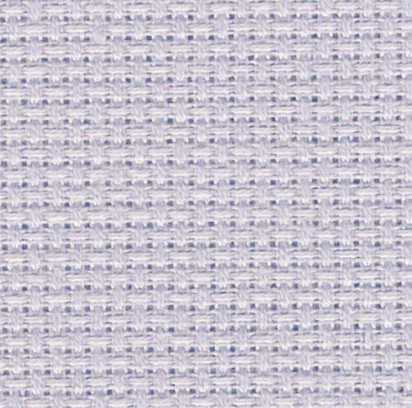
Aida fabric is certainly the single most popular cross stitch fabric. The name "Aida" refers to a particular weave of the fabric that was invented by Zweigart in 1908.
Aida is generally made from 100% cotton, and it comes in several different counts as large as Herta (6 count) and as fine as 20 count. Herta is often used for teaching children or beginners to cross stitch because it is easy to see. 18 and 20 count fabrics are for more experienced cross stitchers that are looking for a finer or more detailed look to their piece.
The fabric is made by little squares with four holes at the corners. The stitches are formed using these holes. It is available in many different counts, but the most common are 14, 16 and 18 count, that means respectively 14,16 and 18 stitches per inch - so, the higher is the count, the smaller will be your work.
Fractional stitches (1/4 stitches and 3/4 stitches ) can be much easier to do on an Even-weave material. On Aida, the needle needs to punch through the middle of the little square in order to complete the stitch.
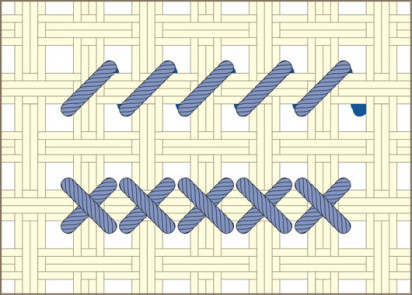
Aida Country French: is a cotton Aida even weave fabric that has a very soft, luxurious texture. It is great for baby quilts, clothing or washable items. It drapes nicely and comes in a variety of neutral colors. It does however fray quite easily, so it is best to surge or tape the edges when working with it.
Aida Yorkshire: 14 count fabric is made of 96% cotton and 4% polyester. It is a rustic fabric and a unique alternative to regular Aida.
Evenweave:

The term evenweave applies to any fabric that is "evenly woven", so any fabric which has the same number of threads per inch in both the vertical and horizontal directions, and all the threads have the same thickness.
The count is different from Aida, because in this case, we do not count the squares, but the threads. Normally evenweaves are worked "over two threads" (when you are following the chart you would miss one hole and go into the next) so basically you stitch on a square of 2x2 threads. In this case, you have to take the count of the fabric and divide it by 2 to have to correct the size of your work.
For example, if you want to have the same design size of 14 count Aida (14 squares per inch), you could work it on 28 count (28 threads per inch) fabric, over two threads (28/2=14). The cross stitches would be exactly the same size, and therefore the complete design would be the same size. This also has the advantage that part stitches are easier to do, as a hole already exists in the middle of each square.
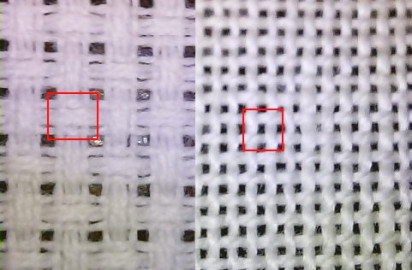
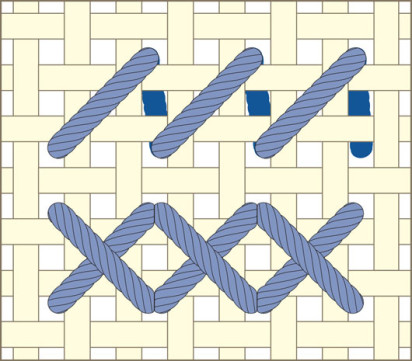
The most common count of evenweave are 28 count (= 14 count Aida if stitched over 2), 32 count (16 count Aids if stitched over two) and 36 count (18 count Aida if stitched over two)
Evenweave can also be stitched over one thread, and in that case you will have a proportion stitches/inch equal to the fabric count (i.e. 28 count = 28 stitches per inch)
Linen:
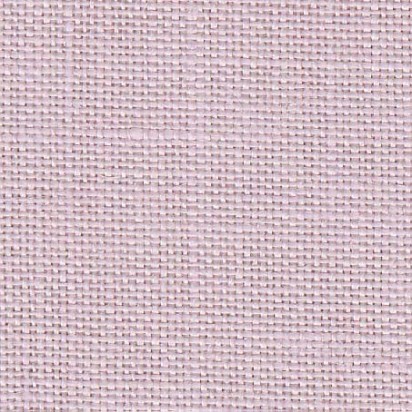
Linen is a natural fiber. The main difference between linen and evenweave is that linen threads have not all the same thickness, so basically the stitches per inch may not be equal vertically and horizontally.
The stitching method and the count are the same as the ones you use for evenweave, and it can be stitched over one or over two exactly as evenweave.
Linen has a very "crisp" feel and offers a more “old fashioned” look to a piece. Traditional Linen has a very rustic look to it, especially in the more natural colors like "raw linen". Linen comes in several different counts including 18, 22, 26, 28, 30, 32, 35, and 40 count, which are usually identified by the name. The most common are:
Linen-Hardanger: (even weave) fabric is made of 100% linen and comes in 16 count. It is usually stitched over one thread and is a course fabric. The holes are prominent. It is a unique alternative to Aida fabric.
Cashel Linen: 28 count Linen also comes in a large array of colors and is stitched over two in most cases. It is 100% linen and less stiff than regular Linen fabric.
Belfast Linen: 32 count Linen comes in a large variety of colors and is normally stitched over two threads. Belfast is 100% linen and is softer than regular Linen.
Edinburgh Linen: 36 count Linen comes in a few neutral colors. It is made of 100% linen.
Newcastle Linen: 40 count Linen comes in a few neutral colors. It is made of 100% linen.
Other cross stitch fabrics:
Sulta: Has a precise square pattern weave - which means obtaining even stitches is easy. Ideal for cross-stitch or stitching.
Jobelan: is popular because of it's elegant, soft, smooth sheen and a large variety of colors, including hand-dyed fabrics. Jobelan comes in 20, 25, 28, and 32 count and is made of 51% Cotton, 49% Rayon/Modal. Jobelan drapes nicely and is a pleasure to work with. It is resistant to wrinkles.
Lugana: is a heavy fabric that is very versatile and similar to a Jobelan. Lugana comes in many colors and it is a blend of 52% cotton and 48% Viscose. Did you know that Lugana used to be called Brittney fabric? Lugana is a soft, heavy, even weave fabric that is easy to count and great for cross stitch. It comes in many colors and a few different counts like 25, 28, and 32 counts with the most color choices in 25 count. Lugana is an elegant fabric for table linens, samplers, pillows, and other decorative accessories. Lugana is also a great choice for Hardanger projects.
Tula: 10 count fabric is made of 60% rayon and 40% cotton, usually stitched over one. The holes in Tula fabric are prominent. It is a soft, unique fabric. It comes in some lovely colors.
Waste Canvas: is used to stitch your design on fabrics that are not cross stitch friendly, like denim or T-shirt cotton fabric, table cloths, and napkins. Waste canvas comes in several different counts from 6.5 to 20 count. Waste canvas is usually marked with a grid in blue that breaks the canvas down into 10 count squares (just like a pattern) which makes it easy to count and to position your design in the center. Some people choose to use some fabric on the inside of the material they are stitching on to give added support to their stitches. This is called interfacing. Using a 6 stranded floss, you will generally stitch with two strands of floss. However, this is something that is left up to you to decide. If you are concerned that the floss colors will run, then you can soak each color of floss in water to remove any excess dye before stitching. To begin your design, be sure to center the waste canvas on your shirt, blue jeans, etc. You can baste or pin your waste canvas and interfacing with your project. Be sure to secure your floss firmly so it doesn't come undone when you wash your garment. Once you have stitched your design to your garment and you are finished, wet your waste canvas and gently pull it out from under your design so that all that is left is the design you have stitched on the garment. It is best to wash your garment turned inside out. Make sure the edges of your interfacing are trimmed close to the design so as not to be caught during the washing process and pulled off.
Original article seen on cloudsfactory.net